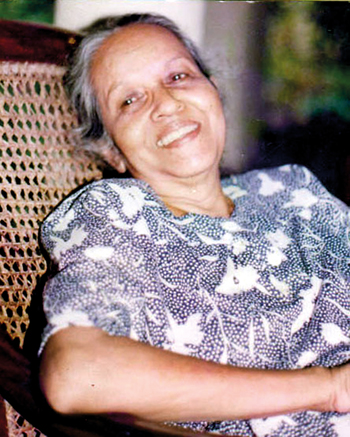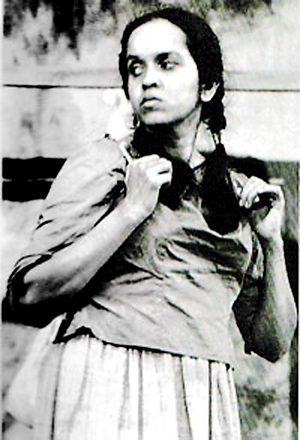Irangani – the one and only

A lifetime in theatre,cinema and teledrama: Irangani in a relaxed mood (file pic)
In the latter part of the 1950s when I was attached to the news desk of the Ceylon Observer (the paper was then printed every day and released in the afternoon), our daily routine was to give the material for the first edition and move to the Fort YMCA for breakfast. After breakfast Clarence Perera (chief sub-editor), Manik de Silva and myself shifted to Studio Times, (then at the heart of Fort in the Times of Ceylon building) for a chat. Studio Times pioneers Nihal Fernando and Pat Dekker were early birds and we used to meet them for a chat. Occasionally Irangani Serasinghe turned up. Possibly it was the time she was a freelance writer to the Times.
Being an ardent nature-lover, Irangani who later went on to form ‘Ruk Rakaganno’ to protect trees from being arbitrarily cut down, discussed the problem with Nihal and Pat who were equally keen on safeguarding trees. I was a silent listener.
During my university days at Peradeniya we used to see Irangani often getting about from the lecturers’ quarters quite close to Jayatilaka Hall. She was then married to Professor S.B. Dissanayake, Professor of Dentistry and lived in the university quarters below Marrs Hall. (They later divorced and Irangani married actor Winston Serasinghe.)
When Newman Jubal, the Hungarian expatriate then living in Australia (having escaped the Nazi holocaust), came on the invitation of Professor Lyn Ludowyke, and produced Maxim Gorky’s ‘The Lower Depths’, Irangani played Nashtya, the prostitute, in a production to mark the opening of the Lionel Wendt Theatre in December 1953.Then came ‘Macbeth’, after which it was the ‘Stage & Set’ production, ‘The Caucasian Chalk Circle’ directed by Ernest McIntyre, our contemporary at Peradeniya.
Irangani Meedeniya first appeared on stage in ‘The Second Mrs Tanqueray’ produced by Professor Cuthbert Amerasinghe as an undergrad aged 21. Then she played the lead role in ‘Antigone’ and Professor Lyn Ludowyke’s ‘Twins’. She was in the ‘Pageant of Lanka’ staged for the country’s Independence (1948), and played Sita opposite Chitrasena in ‘Rama, Ravana & Sita’ produced by Seebert Dias, Chitrasena’s father – the well-known Tower Hall dramatist.
Keen on learning drama, she went to the Old Vic Theatre School in Bristol, and the Central School of Speech Training and Dramatic Art in London.
Irangani felt disappointed by the divide between Sinhala theatre and English theatre. “Many of us thought that it was ridiculous that artistes should be divided by language, artistes of the same country. There was no denying that there was a cultural difference, we who were educated in English had a kind of bastardised culture – ‘thuppahi’, as Philip Gunawardena (minister) called it. Nevertheless we were, I think, creative, vibrant and active,” Irangani wrote in ‘Memories in a sieve’ for ‘Applause at the Wendt’ – the Theatre’s golden jubilee publication, edited by Neville Weeraratne, painter/author.
She was jubilant when the Art Centre Club was formed at the Wendt. “The much-longed-for-happening took place: Sinhala theatre and English language theatre got together…. Actors, dancers, singers, photographers, painters, architects, musicians and writers. An evening at the Art Centre Club was a gloriously stimulating experience. And since the theatre itself is an intermingling, a cohesion of all the arts, what a contribution it was for our own theatre!” she reminisced.
Referring to the “flowering of the Sinhala theatre then”, she found great hope and inspiration from Dr. Sarachchandra (starting with ‘Maname’ and ‘Sinhabahu’), Henry Jayasena, Dayananda Gunawardena, Dhamma Jagoda, R.R. Samarakone, Sugathapala de Silva, to name a few. As for the English theatre, she said: “A very active ex-university group, Stage & Set burst to the Lionel Wendt with a bang. Led by Ernest McIntyre, Haig Karunaratne, Shelagh Jansen (now Goonewardene), Karan Breckenridge, Sriyantha Senaratna and others naturally and joyously forged the link between English and Sinhala theatres.”
If not for this ‘happening’, we may not have been able to enjoy Irangani’s presence in Sinhala theatre and cinema. After the doors of Lionel Wendt were opened for ‘Maname’, those involved with Sinhala theatre felt ‘wanted’ there. As an active member of the Art Centre Club Irangani urged them to come over and enjoy an evening. She mingled with them making them feel at home.

Poignant portrayal: The young Irangani as Ranmenike in ‘Apata Puthe Magak Nethe’
Sinhala theatre
Henry Jayasena was the first to approach Irangani to act in one of his plays. It was mid-1968. I was then on the Observer. We had a headline story about a university student committing suicide because of poverty. His mother worked at a quarry from morning till night trying to earn a living. Henry made this the theme of ‘Apata Puthe Magak Nathe’ with Irangani playing the role of the helpless mother, Ranmenika.
“As I was writing the script, I was picturing Irangani. Her face and lean body were ideal for the mother’s role. For the son’s character, my choice was Douglas Ranasinghe,” Henry writes in his autobiography, ‘Nim Nethi Kathawak 2’. “I was correct. Both did their roles exactly the way I thought they would. They were excellent.”
Henry recalls the last scene in the drama where the mother poignantly begs the son’s pardon and asks him why he didn’t have a little more patience taking a cue from her. “Wherever I was – whether inside or outside the hall – I never missed watching this scene…. She did it with so much feeling. I think Irangani did this role over a hundred times. Every time I watched, I was simply dazed. With a few words she created a whole world on stage. Here was a mother who, in spite of losing her only son spoke with restraint and pride how she would continue her struggle to live without bowing down to injustice and unfairness. I myself gained so much courage from this wonderful actress,” he writes. What more can a director say!
The play was first banned – the first time a Sinhala drama faced a ban by the government, but was later allowed. Within six months there were 50 shows.
Irangani was to show her talent in two other Sinhala dramas – Dhamma Jagoda’s ‘Ves Muhunu’ and ‘Porisadaya’. She also acted in several more English plays including Shakespeare’s ‘Macbeth’ and ‘Othello’ while being a journalist at the Times of Ceylon.
On to cinema
Irangani broke into cinema in 1955 when Lester James Peries picked her for the short film, ‘Be Safe or Be Sorry’ he did for the Traffic Police. The following year, she was in the ‘Rekava’ cast – the first Sinhala film to be filmed outdoors. In her autobiography ‘Irangani’, she recalls how even though not many approved Lester’s idea of shooting outdoors, he went ahead. “Even the sound was recorded outside. This guy managed marvellously in spite of crows and ‘kohas’, the dogs and the chicken. There was just no dubbing. Today everything is dubbed.” Winston too acted in the film.
Playing a village mother in her first feature film, she was adjudged Best Actress (1956) at the Lankadeepa Deepa Shika film awards – the only awards at the time. Lester picked her for his later films – ‘Sandeshaya’(1960), ‘Delovak Atara’ (1966), ‘Ran Salu’ (1967), ‘God King’ (1976), ‘Avaragira’ (1995) & ‘Wekande Walauwa’ (2003). She won the Sarasaviya Best Actress award in two successive years – in 1995 for Ranjith Kuruppu’s ‘Pavana Raluviya’ and in 1996 for ‘Avaragira’. Both were roles where she was an elderly woman. She was Best Supporting Actress at the Presidential Awards (1986) for her role in Chandran Ratnam’s ‘Adara Kathawa’ and again in the 1997 Sarasaviya Awards in Sumitra Peries’ ‘Loku Duwa’.
As a character actress, she would take on challenging roles. Once she played a prostitute in a Govt. Film Unit documentary on social diseases. In ‘Kimihiriya Mal’ she was a ‘madam’ running a house of ill fame. Fans and relatives who expected her to play the loving mother all the time were shocked.
She acted in a host of other films which made her a known figure among Sinhala film fans. However, it was the tele-dramas that brought her close to their hearts. Her first TV role was in Parakrama Niriella’s ‘Yashorawaya’ scripted by Somawira Senanayake, playing Sudu Hamine, Baladeva’s (Lucky Dias) mother – the housewife who had to make ends meet in the house, perfectly. In Nalan Mendis creation, ‘Doo Daruwo’, she was Dulcie, an ageing widow with Henry Jayasena playing the male lead as Sudu Seeya -another of Senanayake’s scripts that was also well received by viewers.
Shelagh Goonewardene summed up her career thus: “Irangani Serasinghe occupies a unique place in our theatre, combining in herself many of the significant elements in our dramatic tradition. She has had access to a professional training in English Speech and Drama, yet this has not cut her away from her native roots but rather, has enriched and strengthened them. An actress who invests the stage with dignity and meaning, whose p erformances fascinate an audience and instruct her fellow-actors simultaneously, she is one of the most completely dedicated and professional personalities in theatre, yielding performances that are at once technically assured and perfectly natural.” (‘Abhinaya’ Felicitation volume).
Greetings to the Kumarihamy who hailed from Ruwanwella. True to her pet name Chandi, the mischievous one, she conquered the Sinhala and English stage and screen – both big and small.
Chirang Jayatu!


